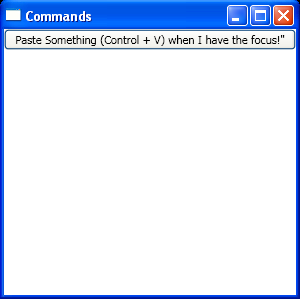Bind ApplicationCommand to a handler

<Window x:Class="Commands.Window1"
xmlns="http://schemas.microsoft.com/winfx/2006/xaml/presentation"
xmlns:x="http://schemas.microsoft.com/winfx/2006/xaml"
Title="Commands" Height="300" Width="300">
<Grid>
<StackPanel>
<StackPanel.CommandBindings>
<CommandBinding Command="ApplicationCommands.Paste" Executed="InvokeApplicationCommand"/>
</StackPanel.CommandBindings>
<Button Command="ApplicationCommands.Paste">
Paste Something (Control + V) when I have the focus!"
</Button>
</StackPanel>
</Grid>
</Window>
//File:Window.xaml.cs
using System;
using System.Collections.Generic;
using System.Text;
using System.Windows;
using System.Windows.Controls;
using System.Windows.Data;
using System.Windows.Documents;
using System.Windows.Input;
using System.Windows.Media;
using System.Windows.Media.Imaging;
using System.Windows.Shapes;
namespace Commands
{
public partial class Window1 : System.Windows.Window
{
public Window1()
{
InitializeComponent();
}
void InvokeApplicationCommand(object target, ExecutedRoutedEventArgs args)
{
MessageBox.Show("The ApplicationCommand has been invoked.");
}
}
}
Related examples in the same category